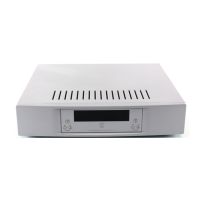1.7.2: Polling Explained
The RS232 interface hardware, via the POLL command, allows communication to daisy-chained RS232
controlled devices. The devices must be capable of buffering data for transmission as required.
Using this feature allows the host to „auto-detect‟ the slave products on the RS232 link.
By taking advantage of this, it is possible to identify what is on the link using the following type of algorithm:
$POLL START$
- opens return-path switches in all devices, so only first device in chain can respond
$POLL ID$
- all devices respond but only response from first device reaches host
@dest_1_id@$POLL SLEEP$
- where „dest_1_id‟ is the result of the previous „POLL ID‟
- matching product closes its switch
- product will not respond to any command now until „POLL DONE‟ command received.
$POLL ID$
- second device can now respond with it‟s ID
@dest_2_id@$POLL SLEEP$
- where „dest_2_id‟ is the result of the previous „POLL ID‟
- matching product closes its switch
- product will not respond to any command now until „POLL DONE‟ command received.
The „POLL ID‟ and „POLL SLEEP‟ commands are issued repeatedly until all products have been queried and
there is no response from the last „POLL ID‟ command.
$POLL ID$
- no response since all product id‟s read, so time-out
$POLL DONE$
- resync all products on link again

